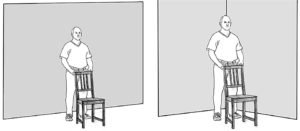First and foremost trust your gut. If something feels unsafe, back off. Be especially careful if any of the following risk factors are present.
Risk Factors:
- Fear
- Fatigue
- Pain
- A history of frequent falls
- Cluttered environment
- Distractions
- Uneven surface
There is a certain amount of unconscious and conscious risk assessment that goes hand in hand with movement. Balance always demands concentration, more or less depending on the demands of the moment. Pay attention to what you feel, especially anxiety or fear. Stay focused. Filter out or eliminate the source of distractions when doing balance exercises on your own. Don’t push too hard. Fatigue is a risk factor for falling.
Shoes:
 Avoid sandals or anything that lacks a strap around the heel such as flip flops or bedroom slippers. Shoes that have a substantial lift in the heel will a tip a person forward and distort normal balance control. Start with flats, especially if you feel unstable. Many people like to work in socks or even barefoot. That is fine.
Avoid sandals or anything that lacks a strap around the heel such as flip flops or bedroom slippers. Shoes that have a substantial lift in the heel will a tip a person forward and distort normal balance control. Start with flats, especially if you feel unstable. Many people like to work in socks or even barefoot. That is fine.
Clothing:
Loose fitting clothing that allows for freedom of movement works best. Make sure hems are high enough so that they don’t get underfoot. Use layers to control temperature.
Space:
If possible, work in a space that is well ventilated, temperature controlled, and that allows for freedom of movement without feeling constrained.
Surface:
- Level, smooth, and uncluttered
- Carpeted is nice- but not so thick that you feel unstable
Chairs:
The chair is a tool. When seated, the chair allows us to isolate and condition various elements of the balance system without the stress of having to balance or support all of the body weight.
Choose a chair that has a level seat and a back rest that is at least waist high so that you do not have to bend forward when resting the hands on the backrest. When standing, position yourself close enough to the chair so that you do not have to lean or step forward in order the grab the chair in the event of a balance loss. The chair is a safety net. If you feel unstable, use it. The objective is to get stronger. The chair assists the process.
- Do not use a chair that swivels, slides easily on the floor, or has wheels – even if they lock!
 Walkers:
Walkers:
In some cases, a walker can be substituted for a chair. It is a matter of what feels most secure to the individual. In my experience, a chair is a little easier to work with because it doesn’t interfere with the feet as much as a walker. If your walker has wheels, be sure to lock them! Adjust the height so that you are vertical.
Walls:
If there are concerns about falling backwards, stand between a wall and your chair. Stand close enough to the wall so that it will act as a net if you fall backwards – six to eight inches. If security is still uncertain, position yourself in a corner with the chair in front. If you start to fall, this setup will provide plenty of surface to lean on.
It is very important that we feel comfortable and relaxed, especially when doing the standing exercises. A balance training session should lower stress levels over all, not elevate them – especially for a person who has suffered a bad fall and is dealing with fear.

Leave a Reply